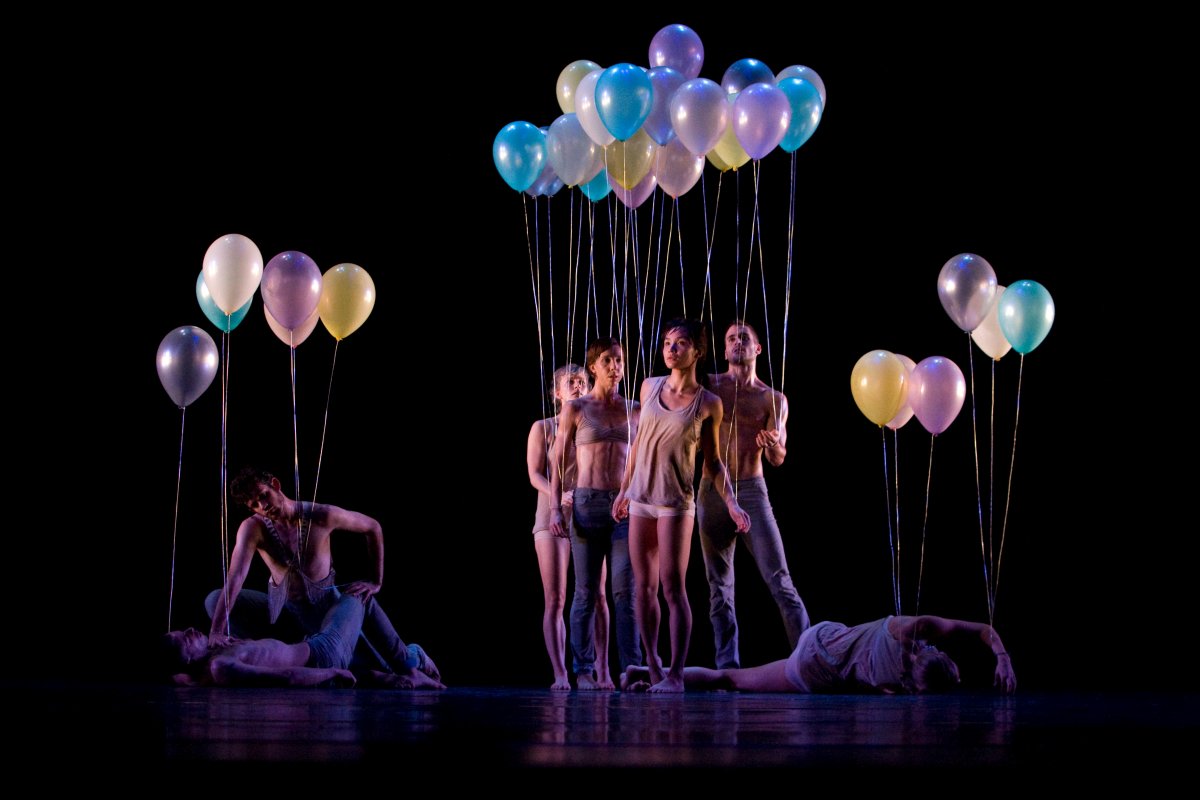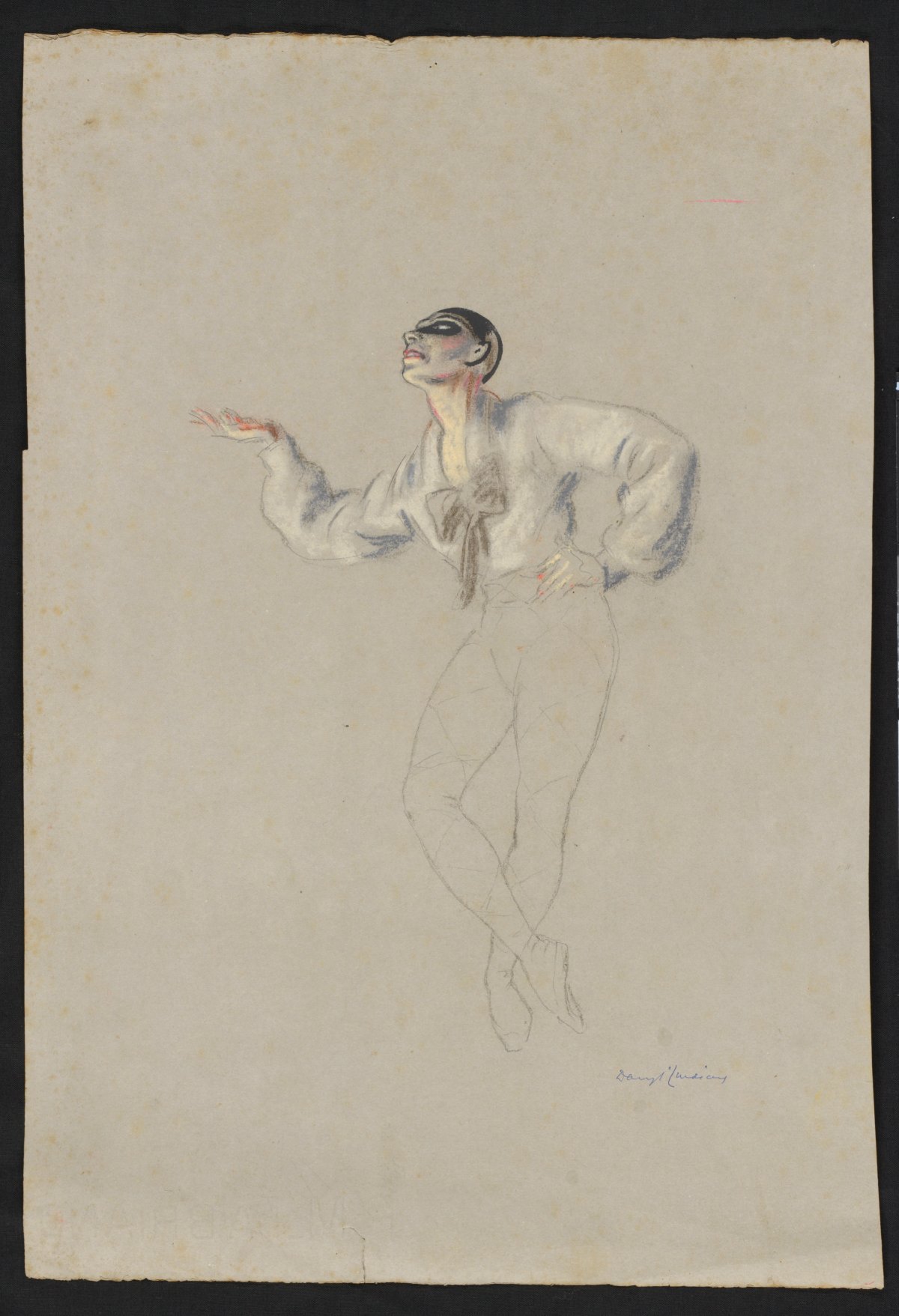
Cooper, Samuel, 1982- & Linder, Adam. (2010). Dancers on stage during dress rehearsal of Sydney Dance Company's Are we that we are, Sydney Theatre, Sydney, 2010 [picture] / Sam Cooper. http://nla.gov.au/nla.obj-132086627

Lindsay, Daryl, 1890-1976. (1938). Pierrot from the Ballet Russe Carnaval, ca. 1938 [picture] / Daryl Lindsay. http://nla.gov.au/nla.obj-137359849
The history of dance performance in Australia, as with all the performing arts, precedes the arrival of settlers from other nations. The melding of both ancient and modern culture now sees Australia with a dynamic array of performance dance. Costume is as important to dance production as it is to drama.
Indigenous Dance
Ceremonial dancing has a very important place in the Indigenous cultures of Australia. Ceremonies vary from place to place, but most combine dance, song, rituals and often elaborate body decorations and costumes. The different body paintings indicate the type of ceremony being performed.

Webster, Tim (Timothy James), 1965-. (1993). Stephen Page with poster for "Praying mantis dreaming" [picture] / Tim Webster. http://nla.gov.au/nla.obj-136369970
Bangarra Dance Theatre
Founded in 1989, Bangarra is Australia’s premier dance company bringing Australia’s First Nations stories to a broader audience. Praying Mantis Dreaming, written in 1992, was its first full-length work, created by Nunukul Munaldjali man, Stephen Page, who also served as the company’s artistic director. Praying Mantis Dreaming told the story of a young girl who travels from her country to the city, guided by the Praying Mantis Spirit. Stephen Page and his brothers, Russell and David, were core members of the Bangarra Dance Theatre.
Professional Dancer
Noel Tovey was the first Indigenous man to work as a professional dancer, using his performance in a one man show to tell the story of his extraordinary life overcoming adversity. He played the lead role in Skipping on Stars, based on the life of Indigenous tightwire walker Con Colleano, performed to celebrate the 25th anniversary of the Flying Fruit Fly Circus.
Djuki Mala Dance Troupe
World famous after their performance in full ceremonial dress on YouTube, the Djuki Mala dance troupe hails from Elcho Island, which lies off the coast of Arnhem land in the Northern Territory. Their style of dance employs a comedic element while embracing the traditional costumes and body paint, with gara (spears) and galpu (spear throwers). Their performances draw on traditional works and feature movement and performance elements that have origins in Yolngu culture.
Ballet

Dupain, Max, 1911-1992. (1938). Portrait of Irina Baronova in Choreartium [picture] / Max Dupain. https://nla.gov.au/nla.obj-139588424
While homegrown theatre and performance flourished, Australian performance companies began to bring overseas artists to our shores to perform. Between 1936 and 1940, three ballet companies — formed out of the famous Russian ballet troupe the Ballets Russes — toured Australia. These tours, organised by J.C. Williamson Ltd, had an enormous impact on the history of dance in Australia. Some of the dancers stayed on in Australia, including Hélène Kirsova and Edouard Borovansky, both of whom established their own ballet companies.
Coming to Australia with the Ballets Russes, Irina Baronova (1919–2008) was one of the youngest members of the ballet corps when it toured Australia in 1938–1939. Giving an oral history interview, which was recorded by the National Library of Australia and can be listened to here, Baronova recalled what she remembered most: ‘The reception we were getting and the amount of people that came on the pier to see us off, people from the audience ... That was so touching … we never experienced [this] anywhere else.’

Lansac, Regis, 1947-. (1984). Portrait of Meryl Tankard, Sydney, 1984 [picture] / Regis Lansac. https://nla.gov.au/nla.obj-140461142

McFarlane, Jim, 1955-. (1994). Justine Summers in "Divergence", the Australian Ballet, 1994 [picture] / Jim McFarlane. http://nla.gov.au/nla.obj-136367403
Continuing Australia’s ballet scene, the Australian Ballet was established in 1962 under the artistic direction of Peggy van Praagh. The Australian Ballet began touring overseas the following year. In the 1960s and 1970s two icons of the ballet world, Margot Fonteyn and Rudolf Nureyev, boosted the company’s profile and brought Australian ballet to the world stage by taking lead roles in performances during the Australian Ballet’s season in France.
Meryl Tankard, one of Australia’s finest contemporary dancers, began her career as a dancer with the Australian Ballet. After three years she left the company to join Pina Bausch’s ensemble, the Tanztheater Wuppertal. Tankard danced with the company as a principal soloist for a period of ten years, dividing her time between Europe and Australia. In 1986 she wrote and directed Travelling Light and in 1988 she created a solo work, Two Feet, based on the life of Russian Ballets Russes ballerina, Olga Spessivtseva, who toured Australia in 1934.
Activities
- Have the students define the following terms in relation to dance:
- Body
- Action
- Space
- Time
- Energy
Once students have defined these terms, have them demonstrate these elements in short improvised dances.
- Watch a dance performance and ask the students to discuss the following:
- How did the dancers/you use space and energy to create a feeling of strength/isolation/happiness?
- What is the relationship between the dancers and the audience?
- As a homework activity, have students ask their parents, grandparents, older siblings or guardians what kind of dances were popular when they were younger. Have the students compare these dance styles with their favourite dance moves. Are there any similarities? Do people still do these dances?





